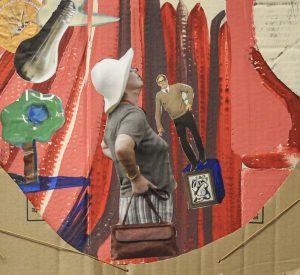
“Artworld,” (detail) Cardboard, String, Mixed Media
One of the most intriguing aspects of a collection of artefacts is what criteria guided the collector’s selective process and what emotions are expressed in his or her relationship with those artefacts. Why did they carefully take objects from somewhere to a different environment and unify them into a structured whole. Part of my Anthropology of Art research has been driven by my interest in verifying if the acquired objects function as a “memory activator” in the sense that visual and tactile contact triggers an emotion associated with what it represents in terms of a life story or even past traumatic experiences. There is a cause↔effect relationship between collectors’ chosen theme and media and the building of his or hers private art collection.
In conclusion, the emotional relationship that a collector has with hers/his artefacts is more historically relevant in defining the collection than the simple accumulation of objects. The acquisition of the artefacts is not simply dictated by taste, nor by mere technological interests, there emotional aspects that cannot be ignored.
Art consumption behavior is fascinating for its complexities. Many people seem to love to go to museums and galleries. My perception is that a very few percentage of museum goers are actually art buyers. However, it seems that most art buyers are museum goers. I want to learn more about the art buyers and mapping their types of consumption. By learning art buyers profiles more could be done to educate the new generation on the value of original artworks and present art acquisition as an alternative to other consumerist behavior.
